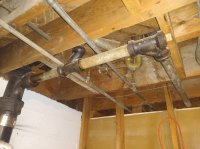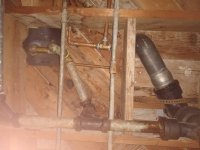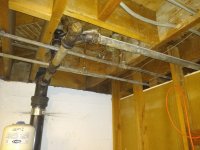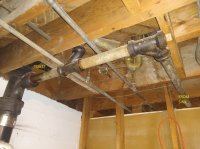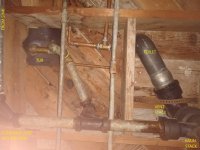JeffK
New Member
I'm in Seattle and have 1955 home, one story with full basement, that we've owned for 5 years. It has a chronic slow drain that is prone to clogging at the main floor bath. I usually can snake it out with the smaller of the two snakes I have but it's a battle each time. I've been using the Bio-Clean product and it helps some but feels like another part of this band-aid approach to maintenance. I'm figuring the actual ID available in the pipe is dime sized in some areas and hair can clog it easily. I'm ready to go to the next level to remedy this headache.
The plumbing is all accessible from the basement and it's next to the main stack. The tub (see brass p-trap) and bath sink (line that comes in furthest away from the stack) are both independently and together prone to slow draining and frequently clog every other month or so. I have reefed on the cleanout at the end of this horizontal line as hard as I dare after letting penetrating fluid sit on it and it will not budge.
We had our sewer line replaced this year as a separate issue and I had the guy replace a section of the stack just above the floor to about 6', the gasketed clamp can be seen in the pics. I'm wondering about replacing the exposed cast iron and galvanized waste line in the pics as a DIY project. I'm handy around the house but haven't done any plumbing type things other than replace faucets and some tightline from the downspouts to a rain garden. I'd love for this to be a $100 weekend project and not a check writing exercise (still recovering from the sewer job!).
Questions & assumptions -
Is this just a replace what's there with modern ABS job?
I presume I'll use more radiused turns.
Use a gasketed clamp to attach to the bath drain line so as not to go in to the wall/finished basement ceiling.
The cast iron vent stack is the only real mental hang-up I have. It must weight a fair amount, although it is strapped and didn't fall when the sewer guy worked below it. Do I just leave it be, add in a new wye in the stack and gasket-clamp the stack? The toilet waste line wye is right on top of the other wye and this is where the strap runs, I'm concerned the vent might need some other sort of support. Or can these easily be taken out downward? And a new one put in from above?
I'm less concerned about the larger diameter stack above the ABS and gasket-clamp portion, except that the first wye above it seems to need to come out. Is this true? Does it look possible to leave the stack alone and just unscrew(?) the first horizontal galvanized pipe section from the wye? Chip out any crusty bits inside and then how would I attach new ABS to this?
Otherwise, any plumber in the (West) Seattle area can certainly PM with an estimate and quick description of what they would do!
The plumbing is all accessible from the basement and it's next to the main stack. The tub (see brass p-trap) and bath sink (line that comes in furthest away from the stack) are both independently and together prone to slow draining and frequently clog every other month or so. I have reefed on the cleanout at the end of this horizontal line as hard as I dare after letting penetrating fluid sit on it and it will not budge.
We had our sewer line replaced this year as a separate issue and I had the guy replace a section of the stack just above the floor to about 6', the gasketed clamp can be seen in the pics. I'm wondering about replacing the exposed cast iron and galvanized waste line in the pics as a DIY project. I'm handy around the house but haven't done any plumbing type things other than replace faucets and some tightline from the downspouts to a rain garden. I'd love for this to be a $100 weekend project and not a check writing exercise (still recovering from the sewer job!).
Questions & assumptions -
Is this just a replace what's there with modern ABS job?
I presume I'll use more radiused turns.
Use a gasketed clamp to attach to the bath drain line so as not to go in to the wall/finished basement ceiling.
The cast iron vent stack is the only real mental hang-up I have. It must weight a fair amount, although it is strapped and didn't fall when the sewer guy worked below it. Do I just leave it be, add in a new wye in the stack and gasket-clamp the stack? The toilet waste line wye is right on top of the other wye and this is where the strap runs, I'm concerned the vent might need some other sort of support. Or can these easily be taken out downward? And a new one put in from above?
I'm less concerned about the larger diameter stack above the ABS and gasket-clamp portion, except that the first wye above it seems to need to come out. Is this true? Does it look possible to leave the stack alone and just unscrew(?) the first horizontal galvanized pipe section from the wye? Chip out any crusty bits inside and then how would I attach new ABS to this?
Otherwise, any plumber in the (West) Seattle area can certainly PM with an estimate and quick description of what they would do!

